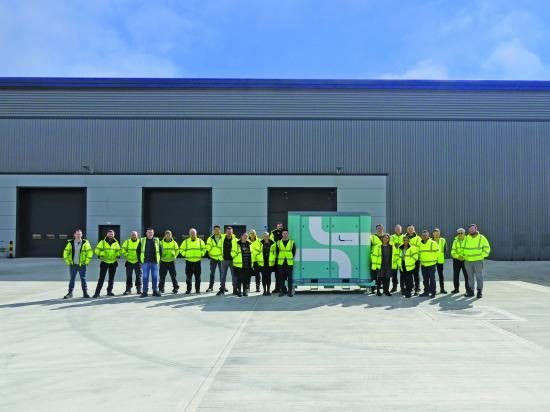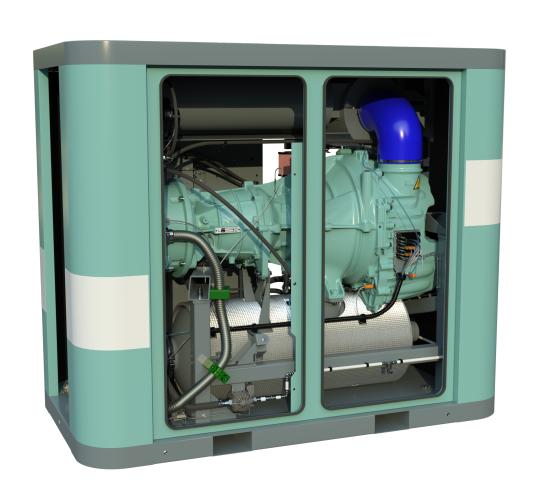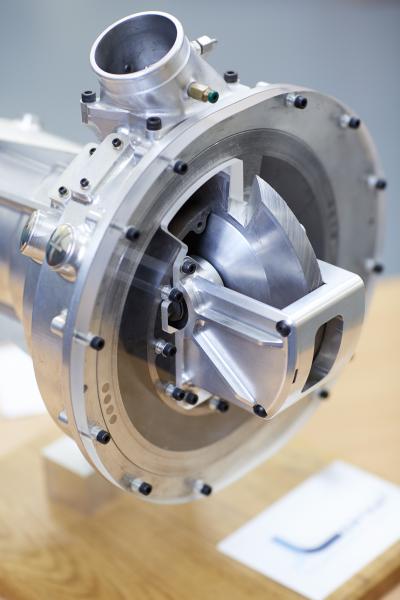Energy efficiency and reliability are two critical considerations in selecting a blower. However, for most WRRF (Water Resource Recovery Facility) operators, reliability is the most important objective. End users need a robust blower system – if the blower can’t be operated, high efficiency doesn’t matter.
High levels of reliability can be achieved in two ways. First, by design – employing quality materials, proven components, and simplified mechanisms. Second, by incorporating advanced monitoring techniques that identify abnormal operating conditions, provide notification to operators, and initiate equipment shutdown before catastrophic failure occurs. Modern positive displacement (PD) blower packages use both techniques to improve system reliability.
Fundamentals
PD blowers deliver a fixed volume of air with each revolution. The blower flow rate is controlled by changing speed, with a linear relationship between speed and volumetric flow. In a PD blower the discharge pressure will always rise and fall to match the system pressure.
Some PD blowers have a fixed volume ratio – the screw blower and blade blower are examples. This creates an optimum pressure ratio, and some over-compression or under-compression occurs at other pressure ratios. The over and under compression will cause a small decrease in efficiency but will not affect reliability.
Centrifugal blowers experience surge, a pulsating flow phenomenon that can cause failure when operated at low flows or high system pressure. PD blowers are not subject to surge, adding to their robustness.
Traditionally blower systems were built from components selected for each individual project. Currently it is more common for PD blowers to be provided as a complete package. [See Figure 1] All accessories, mechanical and electrical, are included in a sound attenuating enclosure. The package components are matched to the blower by the manufacturer and are selected to optimize performance and reliability.

Lontra manufacturing is done in the Manufacturing Centre in Doncaster, UK. The first LP2 PD blower out of this new production facility was in April 2023.
Heat Considerations
Excess heat will shorten a blower’s life. Managing heat is one of the greatest challenges for any blower package. Excess temperature can damage elastomers such as seals and gaskets. Lubrication will fail if heat causes oil viscosity to drop. In extreme cases high temperature will cause warping of blower casings or impellers and lead to mechanical failure.
Efficiency and reliability are linked phenomenon. Efficiency is, of course, a concern for minimizing operating costs. Efficiency also affects reliability, since inefficiencies – mechanical or electrical losses – invariably appear as heat.
There are multiple sources of heat in every blower package. The largest source is the heat of compression. This is an unavoidable result of thermodynamics and is a function of the blower’s pressure ratio.
It is important to note that the heat generated by compression is inversely proportional to the blower efficiency. A high efficiency blower minimizes heat generation. Most of the heat of compression is carried away in the discharge air. The remaining heat is rejected by the blower case to the air circulating through the enclosure.
Additional heat is generated by losses in electrical equipment – primarily the blower motor and VFD.
The VFD is typically air cooled, with the heat exhausted through the blower enclosure and into the blower room. Typical VFD protective functions include monitoring component temperature, loss of phase, low and high voltage, phase imbalance, and high current. As soon as any of these parameters fall outside the allowable operating range the blower system shuts down to prevent a failure cascade.
The motor in newer designs may be a permanent magnet synchronous unit, but standard induction motors are more common. Electrical and mechanical losses are low and heat from motor inefficiency is typically rejected inside the enclosure. The heat from the motor and VFD are then rejected to the blower room.

Figure 1: Interior of a custom-engineered package blower unit.
Lubrication And Mechanical Systems
All bearings in both the motor and the blower are typically rolling element (antifriction) bearings. Many PD blowers use splash lubrication for both the bearings and timing gears. It is important to maintain proper oil levels in the sump to insure proper lubrication.
Some large PD blowers use a pressure lubrication system to increase reliability. A lube pump ensures all bearings receive proper lubrication with clean, filtered oil.
It is common to use V-belts to connect the blower to the motor. V-belts are potential failure points. They rely on proper tension to minimize slip and wear. Excess tension can damage motor or blower bearings. Most package systems include automatic belt tensioning systems, improving both efficiency and reliability.
Blowers rely on receiving clean air at their inlet to avoid mechanical wear of rotating parts. Whether louvered or piped inlets are employed, the package should include internal filters. As the filter removes contaminants from the inlet air pressure loss across it increases. Reliable operation requires proper preventive maintenance of filters.
PD blowers should always have pressure relief valves on the discharge to prevent mechanical damage to the blower or piping from high pressure excursions. Excess pressure may also result in motor overload. The relief pressure should be factory preset to the proper value. The relief valve may vent either inside or outside the enclosure.
Noise
Packaged blower system can be very quiet – less than 80 dBA at rated flow and pressure in some cases. Noise itself isn’t a failure mechanism, but it is an indicator of mechanical vibration. Vibration in turn can lead to fatigue failure. Of course, operator comfort is always a consideration, and low noise levels promote proper operator attention to monitoring and preventive maintenance.
Electrical “noise” is a significant concern for the municipal water and wastewater industry. Of particular concern is the impact of harmonics produced by VFDs on both the blower motor and the other electrical components connected to the line side of the VFD. A modern blower package’s VFD may include line side harmonic mitigation and will meet IEEE-519 voltage distortion requirements. Additional harmonic mitigation equipment is available for special applications.

Figure 2: Internals of the LP2 blade blower from Lontra, a novel type of PD.
Monitoring
Continuous blower health monitoring is recognized as essential in modern blower packages. It can reduce the severity of failures, alert operating staff of issues before they become critical, and provide guidance for troubleshooting and repair.
Proper lubrication is, of course, essential to reliable continuous operation, and therefore comprehensive lube system monitoring is typically provided. Beneficial sensors and safety shutdown for the lubrication system includes:
- Bearing temperature
- Oil temperature
- Oil level
- Oil pressure for pressure lubricated systems
Excess vibration can be an early indication of bearing problems or imbalance issues. Large blowers often employ a case-mounted or bearing mounted vibration transmitter to provide early warning of potential problems.
The inlet air to the blower must be clean and free from dust and debris. Therefore, necessary preventive maintenance includes changing the inlet filter. As the filter collects particles from the air stream its restriction and resulting pressure drop increases. Most packages include a gauge or a sensor that detects the increase in pressure differential across the air filter and indicates that replacement is needed.
Other common sensors and system performance indicators include:
- Discharge pressure transmitter
- Discharge air temperature
- Inlet air temperature
- Inlet suction pressure
|
Lontra LLC Lontra LLC is a UK based engineering and technology company concentrating on the development and manufacturing of innovative compressors. Lontra recognizes that reduced energy usage is important for the environment and society. Their dedication to efficiency and reliability is demonstrated by their flagship product, the Lontra LP2 Blade Compressor, and by their state of the art sustainable manufacturing center. For more information, visit www.lontra.co.uk. |
Communications
Current practice for blower installations almost always includes linking the blower local controller to a Supervisory Control and Data Acquisition (SCADA) or other computer-based Human Machine Interface (HMI) system. This allows operators to monitor critical process and equipment performance data. This in turn increases blower life by providing early warning of unusual operating conditions that may lead to equipment malfunction. Many SCADA systems also incorporate preventive maintenance scheduling. It is universally recognized that proper preventive maintenance will increase blower life. A variety of serial and ethernet protocols are available for linking the blower system to communications networks.
For further operator convenience a local touchscreen HMI is usually provided with the blower enclosure. The HMI shows blower status and performance, allows setpoint changes, and enables local operation of the blower.
Many blower packages implement “cloud” based solutions for optimizing performance and improving reliability. The Industrial Internet of Things (IIoT) has been shown to reduce downtime and improve efficiency through advanced monitoring and big data analytics. IIoT connectivity is standard with many systems.
Summary
Most operators identify reliability as their number one concern with blower systems. Robust systems with high availability are essential for maintaining process performance and permit compliance.
Reliability begins with the basic blower design. Simplicity and ruggedness are key factors. The manufacturing of the blower must be consistent and precise. Finally, advanced monitoring systems must be used to ensure that critical operating criteria are within proper ranges. Early detection of problems can alert operators and stop the blower before catastrophic failure occurs.
Blower package suppliers have considered these factors in their package designs. Great effort is put into meeting or exceeding operator expectations.
About the Authors
Tom Jenkins has over forty years’ experience in blowers and blower applications. As an inventor and entrepreneur, he has pioneered many innovations in aeration and blower control. He is an Adjunct Professor at the University of Wisconsin, Madison and a WEF Fellow. Tom is the current Chair of the ASME PTC 13 Committee. For more information, visit www.jentechinc.com.
To read similar articles on Aeration Blower Technology, please visit https://blowervacuumbestpractices.com/technology/aeration-blowers.
Visit our Webinar Archives to listen to expert presentations on Aeration Blower Systems at https://www.blowervacuumbestpractices.com/magazine/webinars.



